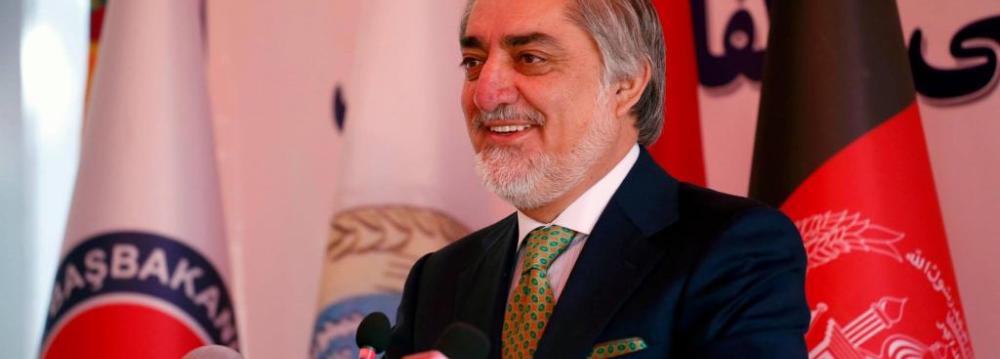Afghanistan’s Chief Executive Officer Abdullah Abdullah, heading a delegation of Afghan officials, is due to arrive in Iran today to discuss ways of boosting bilateral economic ties.
Abdullah is scheduled to visit Iran’s southern Chabahar Port, hold energy talks and discuss issues concerning Afghan nationals in Iran.
Afghanistan’s Trade and Commerce Minister Humayoon Rasaw, Minister of Labor, Social Affairs, Martyrs and Disabled Nasreen Owryakhel, Refugees and Repatriation Minister Sayed Hussain Alemi Balkhi, Transportation and Aviation Minister Mohammadulla Batash, and Deputy Chief Executive Officer of Afghanistan Mohammad Mohaqiq will accompany Abdullah during his three-day Iran visit, IRNA reported.
Trade via Chabahar Port and Free Trade Zone will be a pivotal topic in the Afghan mission’s visit. The port is seen as a viable trade path among Afghanistan, Iran and Central Asian countries such as India, which is financially involved in the development of the port.
The transit corridor has a special significance for Afghanistan, with Afghan President Ashraf Ghani declaring that his country wants to revitalize the Silk Road and act as a regional hub for connecting South Asia with Central Asia.
Afghanistan, Iran and India have signed an agreement to give Indian goods heading toward Central Asia and Afghanistan preferential treatment and tariff reductions at Chabahar.
India has also finalized a plan to build a 900-km railroad from the Afghan province of Bamiyan to Chabahar Port.
Chabahar provides India an easier land-sea route to Afghanistan. New Delhi has already spent $100 million on building a 220-km road in the Afghan province of Nimroz, which will be extended to Chabahar. India has also pledged to commit about $85 million to construct container and multi-purpose terminals at Chabahar.
The Chabahar project is said to be more important to Afghanistan than to any other country. Some experts have called it a bonanza for the economically troubled country, which is expected to suffer even more after the dollars that have been pouring in to sustain the US war machine reduce to a trickle when all residual American troops leave the country by 2017.
In effect, with the development of Chabahar, Afghan trade volumes can soar exponentially, as the country would be able to ship goods more easily to key markets in Europe and the Middle East. It would also be able to import key goods more easily as well.
Talks on the trilateral transit corridor started in 2013. Both Afghanistan and India are focusing on Chabahar and the trilateral transit corridor to reduce their dependence on Pakistan.
“Chabahar Port will reduce dependence of Afghanistan’s freight transportation on routes passing through Pakistan. For Afghan traders, the port will be a replacement for Pakistani port of Karachi as Chabahar is closer to Afghanistan compared to Karachi,” said Mohammad Qurban Haqjo, head of Afghanistan Investment Support Agency.
Access to Afghanistan’s Garland Highway can be facilitated from Chabahar Port using the Iranian road network and Zaranj-Delaram Road constructed by India in 2009. This would establish a direct road to four of the major cities of Afghanistan, namely Herat, Kandahar, Kabul and Mazar-i-Sharif. All this, in turn, is expected to make investors and donors more comfortable about providing financing to Afghanistan.
Moreover, incentives provided by Iran, including granting pieces of land to Afghan traders and investors, which could be used for the construction of manufacturing firms and storage units for perishable goods, according to Haqjo, adds to the importance of the port for Afghanistan.
“Afghans could ship commodities such as fruit to Chabahar where they could be safely stored and then exported to a third destination,” he said.
Iran will also provide Afghans who use the port as a trade pathway with incentives such as 50% reduction in tariffs and storage costs as well as more than 30% discount on fuel prices, according to governor general of Sistan-Baluchestan Province, Ali Osat Hashemi.
Iran’s bilateral trade with Afghanistan currently stands at $2 billion per annum, out of which Afghan exports accounts for a meager $50 billion.
The country has the potential to boost its exports of agricultural products to Central Asian countries.


